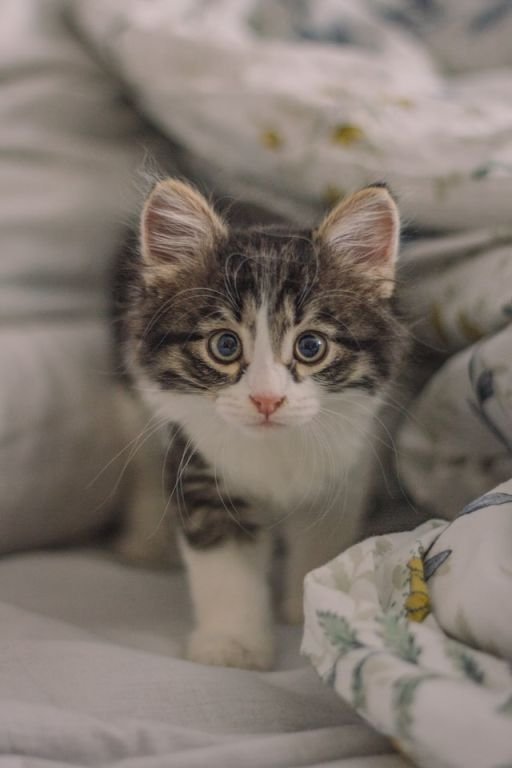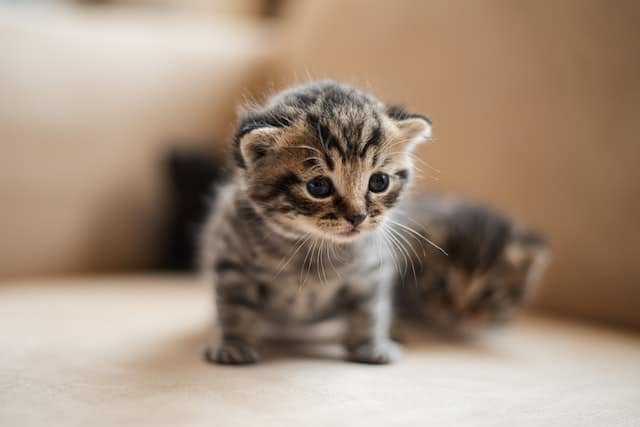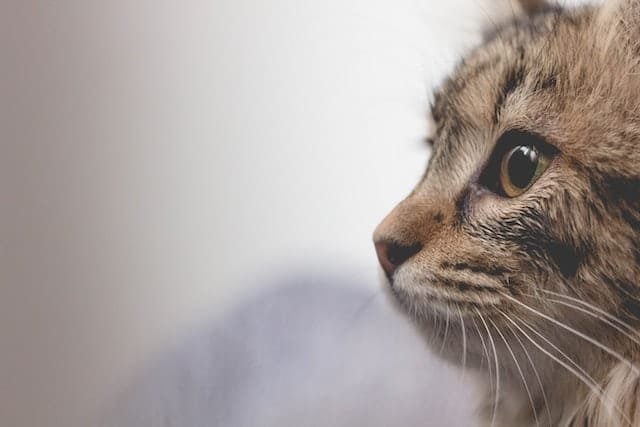Have you ever seen a Dachshund? Of course, you have; who hasn’t? Well, what if I told you that there is a feline version of these cute sausage dogs? That’s right, there is a cat that resembles a Dachshund, and its name is a Munchkin cat!
This cat breed is absolutely adorable. Just like the Dachshund, the Munchkin cat has short legs that give it a cartoonishly cute appearance. Nonetheless, it also has an interesting history, and I would like to share with you everything I know about this cute cat breed!
Munchkin Cat Characteristics
Appearance
| Fur color | White, black, orange, gray, silver, cream, chocolate, lilac, fawn, and sable. |
| Fur pattern | Solid, bi-color. calico, tabby, and color point |
| Fur length | Short and long |
| Eye color & shape | Walnut-shaped and wide-set eyes that can be of any color, unrelated to the fur color. |
| Length | Males 15”-18” Females 12”-16” |
| Weight | Males 6-9 lbs Females 4-8 pounds |
| Expected lifespan | 12-16 years |
Personality
| Temperament | Active, friendly, curious, playful, intelligent, and energetic |
| Kids and other pets | Friendly towards kids and other pets |
| Sociable and cuddly | Extremely sociable and cuddly |
| Activity level | Very active |
Requirements & Traits
| Feeding | The usual cat diet consists of wet and dry meat-based food. Adults should eat 2-3 times per day. Kittens and young Munchkins should eat 3-4 times per day. |
| Grooming | Brushing at least once a week. Nail trimming, teeth brushing, and ear/eye cleaning. |
| Shedding | Moderate shedding. Long-haired specimens shed more than the short-haired ones. |
| Hypoallergenic | No |
History and Origins

Ever since the 1940s, there were several reports of short-legged cat spottings. In 1944, a British veterinarian reported seeing four generations of short-legged cats with all the other features of regular cats. However, during the last months of WW2, all four generations perished.
But, short-legged cats would emerge again in 1956 in the Soviet Union and in the 1970s in the United States. 1983 is the year when Munchkin cats originated as we know them today.
A music teacher from Rayville, Louisiana, Sandra Hochenedel, found two pregnant cats that had been chased under the truck by a dog. She took one of them home and named her Blackberry. Blackberry gave birth to her kittens soon, and half of them were born with short legs.
One of the kittens was male, and Hochendel named it Toulouse. She gave Toulouse to her friend Kay LaFrance. All of the Munchkin cats descended from that Blackberry’s litter and Toulouse.
Munchkin Cat Personality
Munchkin cats may be short when their physical attributes are compared to those of other cats. In spite of that, their personality is just as charming as the other cats. They are intelligent, curious, playful, affectionate, loyal, friendly, and energetic.
Munchkin cats are outgoing and extroverted, and they keep their kittenish attitude well into their adult age. In addition, they enjoy it when people handle them, so when they are not busy playing, they will gladly come to cuddle with their humans.
These cats are friendly to children, especially if the children know how to handle the cat properly. Munchkins are also friendly to other pets, even dogs. They enjoy playing with other animals, so getting a companion for your Munchkin is a great idea.
Munchkins are known to be hoarders. They will steal your things and take them to their multiple hiding spots. Once you discover one of their stashes, you will find things you forgot you even had. Additionally, if you think you have become forgetful and you keep losing things, check the places where your Munchkin hides its treasures. Your stuff is probably there.
When they are curious about something and want to take a better look at it, Munchkin cats will often stand up on their hind legs. Obviously, this makes them even funnier and more adorable.
Munchkin Cat Appearance

Some cat breeds look sleek and elegant, others look majestic and mysterious, and some even look like they are wild. However, there are cat breeds that simply look cute and adorable, and Munchkin cats are one of them.
Legs
The first thing you will notice on a Munchkin cat is its ridiculously short legs. Their legs are, on average, shorter by 3 inches than other cats’ legs. Such short legs are a result of a genetic mutation, but they are completely functional.
Hind legs are a bit longer than the front legs. On both hind and front legs, the upper and lower parts of the legs are equally long. Legs are set evenly apart.
Paws are round, compact, and proportionate with the rest of the body. All four paws point straight forward.
Fur
Munchkin cats can be short-haired or long-haired. Short-haired Munchkins have a coat that’s semi-plush, all-weather, and resilient. It has a medium undercoat. Long-haired Munchkins have a silky and flowing coat, which is also all-weather and resilient. The undercoat is medium to moderate.
The Munchkin cat fur can come in various colors in patterns. When it comes to color, it can be black, brown, white, orange, gray, silver, lilac, sable, fawn, and cream. When it comes to patterns, the fur can be solid, tabby, bi-color, calico, and color point.
Eyes
Munchkin cats have large, walnut-shaped eyes that are widely spaced on the head. As a result, Munchkins have some sort of alert appearance. The eyes can be of any color, regardless of the coat color. This is somewhat unusual because, in most cases, the eye color depends on the fur color.
Anyway, Munchkin’s eyes can be green, yellow, blue, gray, hazel, orange, copper, gold, aqua, etc. They are slightly slanted upwards.
Size
Munchkins are small to medium-sized cats. Males are slightly larger than females, and they weigh 6-9 pounds, as opposed to females weighing 4-8 pounds. The body length is 15-18 inches for males and 12-16 inches for females.
When it comes to Munchkin cats, their height is 5,7 inches on average. The shortest Munchkin cat was Lilieput, a cat from Napa, California. She was only 5,3 inches tall, or should I say, short. In comparison, domestic shorthairs are 8-10 inches high on average. I think this really puts the height difference into perspective.
Other Body Characteristics
Munchkin cats are surprisingly muscular. Their bodies are thick and non-compact. The back slopes gently upwards from the shoulders to the tail. The chest is well-rounded, and the hips are firm. The tail is as long as the body, slightly tapered and rounded at the top. It is erected when the cat is in motion.
The head is wedge-shaped, with rounded contours proportionate to the rest of the body. Cheekbones are high and well-defined, and the chin is firm. The muzzle is moderate and proportionate with the rest of the head. Ears are alert and at the top of the head, and they have slightly rounded tips.
Daily Life With Munchkin Cat
In general, Munchkin cats are easygoing pets that don’t have any specific needs and requirements. You should take care of them just like you would if you had any other cat breed. Here are some general rules to follow:
Feeding
Munchkin cats, just like other cat breeds, are obligate carnivores. In short, this means that they should eat meat-based food. Both dry and wet cat food are good options, and it is recommended that you feed your Munchkin with both types.
Try to provide the highest possible quality of food to your Munchkin. You can also give meat to your cat, but make sure it isn’t full of salt or other spices. Avoid giving milk and dairy products to your cat, especially if it is fully grown up.
Kittens and juvenile Munchkin cats will need to eat 3-4 times a day. Adult Munchkins need fewer meals, and 2-3 meals per day are perfectly enough. If you are unsure regarding the portion size, contact your vet and ask for their recommendation.
Grooming
Short-haired Munchkin cats require fur brushing at least once a week. Long-haired ones, on the other hand, require more frequent brushing. You should trim your Munchkin’s nails once a month and clean their ears when they get dirty.
Try to brush your cat’s teeth frequently. Always use vet-approved pet toothpaste and specialized cat toothbrushes. Start brushing your cat’s teeth while it is still a kitten. This way, it will get used to the process and won’t resist it so much.
If you can’t make your cat accept regular teeth brushing, try offering treats specifically made for removing plaque from the cat’s teeth. As your cat chews on these treats, they clean its teeth a little bit. Obviously, it’s not as efficient as teeth brushing, but it is better than nothing.
Activity
Munchkins are active cats that need plenty of exercise and playtime to stay healthy and entertained. Even when they grow up, they remain as playful as when they were kittens. For this reason, they like to run, hide, climb and even jump.
Although their short legs might prevent them from climbing and jumping as high as other cat breeds could go, Munchkin cats are clever, and they will find a way to reach their desired destination. They quickly learn to climb on some lower items to reach the higher ones.
That’s why you should provide your Munchkin cat with the same cat trees, scratching poles, and other toys that you would get for a normal-legged cat. Munchkin cats also require you to play with them, so make sure to take some of your time for that.
Munchkin cats shouldn’t spend too much time outside as there are many dangers lurking out there. While their short legs are cute, they are disadvantageous in situations in which the cat needs to run away from danger as soon as possible.
Keep your Munchkin cat inside all the time, and make sure it can’t go outside by itself. You could let it play in your backyard under your supervision, or you could take it out for a walk if you leash-trained it.
Most Common Munchkin Cat Health Issues
Munchkin cats are generally healthy, but there are some concerns regarding their short legs and their impact on the cat’s health. Munchkin is still a young breed that still hasn’t shown significant signs of genetic diseases or conditions caused by its short legs.

However, cat experts are worried that in the future, Munchkin cats could become extremely prone to spinal issues and other related conditions because of their short legs. This theory is founded on the experience of short-legged dogs that often suffer from spinal issues and other health complications.
Lordosis
One of the spine-related issues that mostly affects Munchkin kittens is lordosis. The condition involves too short spine muscles, which in turn cause the curving of the spine in the lower back area.
This condition, when noticed on time, can be treated with physical treatments or surgery. If you notice any abnormality with your new kitten’s spine, make sure to take it to the vet as soon as possible.
Osteoarthritis
A degenerative disease that causes the breakdown of tissues in your cat’s joints. If left untreated, it reduces the cat’s mobility and lowers the quality of life. Osteoarthritis is quite painful, and it will make your Munchkin cat nervous and even destructive.
Fortunately, there are several options for treating feline osteoarthritis. Some of them include physical therapy, medication, weight management, dietary supplements, and change in the environment. So, if you notice your cat being unusually inactive and reluctant to jump and run, go to the vet to get the necessary help!
Hyperthyroidism
If your Munchkin’s thyroid gland starts producing more thyroid hormones, it can cause a condition called hyperthyroidism. Hyperthyroidism is characterized by a higher than normal metabolic rate. Your cat will have an increased appetite while still suffering from excess weight loss.
Feline hyperthyroidism can also cause thyrotoxic cardiomyopathy, a type of heart condition. Some other consequences of hyperthyroidism include high blood pressure, high-stress levels, dehydration, vomiting, and diarrhea.
If you notice any of these symptoms, take your cat to the vet. The vet will be able to treat your cat with oral medication, a prescription diet, radioactive iodine therapy, and/or surgery.
Pancreatitis
When the pancreas gland in your cat’s body becomes inflamed, that condition is called pancreatitis. Just like with human pancreatitis, when left untreated, feline pancreatitis can be fatal.
The most common feline pancreatitis symptoms are vomiting, diarrhea, high fever, nausea, lack of appetite, lethargy, and pain in the abdomen. Take your Munchkin to the vet as soon as you notice any of these symptoms.
Uremia
Your cat’s kidneys are responsible for removing many toxins from its bloodstream and body. However, if the kidneys get injured, or your cat’s urinary tubes get obstructed, the kidneys won’t be able to do their job properly.
As a result, toxins that would otherwise be released through urine will return to the bloodstream. This condition is called uremia, and it is characterized by high levels of urea and amino acids in the cat’s bloodstream.
This is extremely dangerous for your cat because its bloodstream is getting filled with toxins. If you notice your cat vomiting, losing appetite, having diarrhea, or being depressed, that could be a sign of uremia.
Uremia can be treated successfully, but only if detected on time. That’s why you should act swiftly if you notice any of the warning signs. Take your cat to the vet, where it will get all the necessary medical help.
Munchkin Cat Name Suggestions
Cute cats deserve equally cute names, but I highly doubt that you will find a name that will be just as cute as a Munchkin cat. Still, there are some cool Munchkin cat name suggestions out there, so let’s take a look at some of them!
- Loki
- Arizona
- Danger
- Wiener
- Bo-Bo
- Pudgy
- Chito
- Tippie
- Mancha
- Tiny Toes
Buying or Adopting A Munchkin Cat?
If you decide to adopt a Munchkin cat from a shelter, it will cost you $75-$150. If, on the other hand, you decide to buy it from a breeder, keep in mind that these cats can be pricey. Their price ranges from $1000-$2300.
When buying your Munchkin cat, try to find a reliable and reputable breeder to show you all the necessary health certifications. Additionally, some Munchkin cat owners suggest taking a look at one or both kitten’s parents. If they seem healthy, well taken care of, sociable, and happy, that’s a good sign that you chose the right breeder.
Both adopting and buying come with their own sets of pros and cons, but the bottom line is that you should take your cat to the vet when you get it, no matter how you got it. This way, you will know if there are some underlying health conditions that you need to be aware of.
Munchkin Cat Alternatives
Finding a cat similar to Munchkins might be challenging, as there are not a whole lot of breeds with such unique body proportions. Most other short-legged cat breeds were actually created by pairing Munchkin cats with other breeds, such as American Curl, Sphynx, LaPerm, Bengal, etc.
Alternatively, you can simply get a small cat breed with normal legs. If that’s good enough for you, you have plenty of options: Singapura, Cornish Rex, Balinese, Abyssinian, Siamese, Sphynx, and the list goes on.
Frequently Asked Questions
Munchkin cats’ expected lifespan is 12-16 years, but depending on their health and other individual factors, they can live even longer.
They shed moderately, and long-haired Munchkins will shed a lot more than the short-haired ones.
Some international cat associations expressed concerns about potential health issues arising from selectively breeding cats with abnormally short legs. As a result, these health issues could cause a lot of suffering to the affected cats.
Yes, they are indoor cats and should be kept inside the house. If you want to let them outside, do it under your supervision and if you are sure there is no danger for them.
Munchkins can get extremely attached to their humans, to the point of being clingy. They require a lot of attention and don’t like being left alone for too long.
Munchkin Cat Fun Facts
- Although their legs are extremely short, Munchkin cats are still quite fast and agile. Of course, they aren’t as fast as the cats with long legs, but they aren’t slow either!
- Munchkin cats come in different leg lengths. Some Munchkin cats have legs that are only slightly shorter than the legs of other cat breeds. On the other hand, there are “rug huggers” Munchkin cats that have extremely short legs.
- Apart from often being compared to Dachshunds, Munchkin cats are also compared to Corgies. Both Munchkins and Corgies maintain kitten/puppy features throughout their lives, which makes them even cuter!
Summary
Munchkin cats will make you fall in love with them with their unique appearance first. Then, they will enchant you with their lovely personalities and goofy behavior. Everything they might lack in height, they will make up with insane levels of cuteness.
Finally, if you like cute animals, and you want your cat to be cuddly, playful, and affectionate, you should consider getting a Munchkin cat! Furthermore, this cat will be a great family pet, and it will also get along with other pets. Get yourself this adorable fur ball today!
